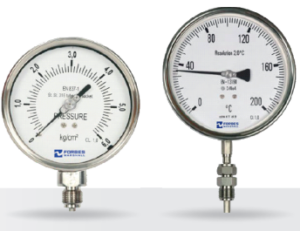Provide pressure and temperature gauges within the steam distribution system
The availability of pressure and temperature gauges within the steam distribution system can make a significant difference in enabling plant personnel to sustain steam system performance.
They serve the following purposes :
Safety:
Pressure and temperature gauges allow plant personnel to monitor and control the steam pressure / temperatures. Timely corrective actions can be taken to avoid / eliminate an over-pressurized system or overheating, thereby preventing accidents.
Uptime:
Pressure and temperature are important parameters in the steam system that can trigger maintenance actions. For example, in case of control valves, changes in pressure / temperature can denote possible malfunction.
Efficiency:
Using steam at the lowest possible pressure for indirect heating reduces the quantum of steam required. This is because latent heat increases with decrease in steam pressure. Pressure gauges in the system can enable plant personnel to ensure precise steam supply pressure to the process.
Troubleshooting:
Pressure/temperature gauges at strategic locations in the steam system can also facilitate troubleshooting. For example in case of pressure drop issues, it can help pinpoint the location and make it easier to arrive at the cause of the problem. A combination of pressure and temperature gauges can also help to detect the presence of air in the system.
Pressure gauges should be installed
- On steam headers
- Upstream and downstream of pressure reducing valves
- On pressure vessels like boilers, flash vessels, etc.
Temperature gauges should be installed
- On process equipment
- At the inlet and outlet of heat exchangers
- Along with pressure gauges within the distribution network to determine the presence of air and non-condensable gases.

